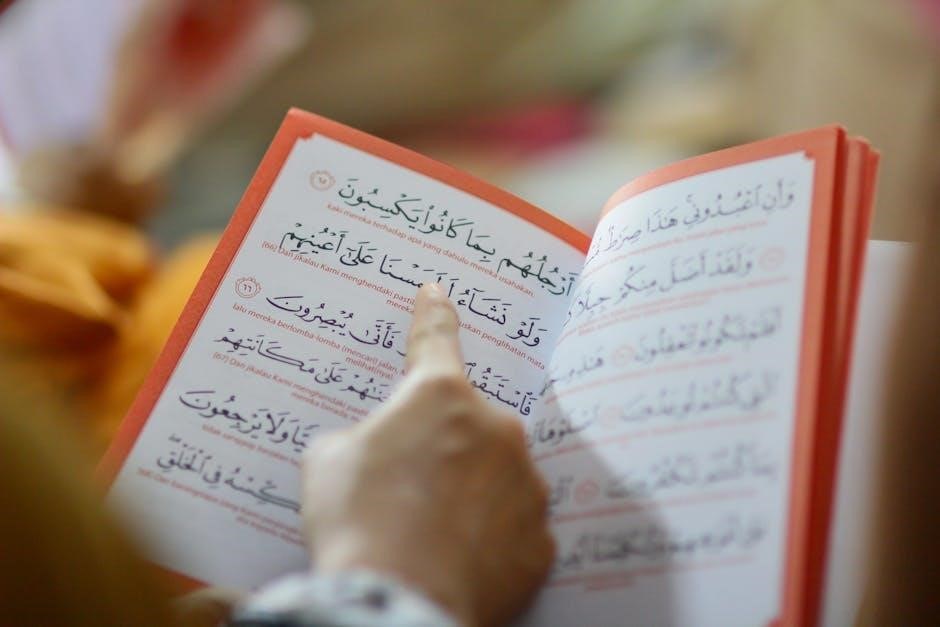plain language big book pdf

plain language big book pdf
The Plain Language Big Book is a simplified version of Alcoholics Anonymous, designed to make the original 1939 text more accessible and easier to understand for modern readers, particularly those with limited reading skills or English proficiency.
Overview of the Plain Language Big Book
The Plain Language Big Book is an adapted version of the original Alcoholics Anonymous (AA) Big Book, designed to make the content more accessible to a wider audience. It uses simpler language and modern phrasing while preserving the core principles and stories that are central to the AA program. The book maintains the same structure as the original, including personal stories and foundational teachings, but presents them in a way that is easier to understand for individuals who may struggle with complex vocabulary or sentence structures. This version aims to ensure that the life-changing message of recovery is available to everyone, regardless of their reading level or familiarity with the material. By simplifying the text, it enhances readability without altering the spiritual and practical guidance that has helped millions achieve sobriety. This approach respects the original intent while making it more inclusive for contemporary readers.
Target Audience for the Plain Language Big Book
The Plain Language Big Book is designed for individuals who may find the original Big Book challenging due to complex language or reading barriers. It targets newcomers to AA, those with limited literacy, or non-native English speakers seeking clarity. Younger readers and people unfamiliar with older terminology also benefit from its modernized phrasing. The simplified version aims to make the AA program more accessible to a diverse audience, ensuring the recovery message is inclusive and understandable for all. This adaptation bridges gaps, helping more people connect with the life-changing principles of the program.

Background and Purpose
The Plain Language Big Book adapts AA’s foundational text for modern readers, aiming to enhance accessibility while preserving the program’s core principles and recovery message.
Historical Context of the Original Big Book
The original Big Book was first published in 1939 by Alcoholics Anonymous (AA) co-founders Bill Wilson and Dr. Bob Smith. It introduced the 12-Step program, becoming the cornerstone of AA’s philosophy. The book detailed the Fellowship’s early experiences, personal stories, and spiritual principles aimed at helping alcoholics achieve sobriety. Its practical advice and hopeful narratives made it a transformative resource for millions. Over the years, the Big Book has remained a vital guide, with its message of recovery and redemption continuing to inspire those seeking sobriety worldwide. Its enduring influence solidified its place as a foundational text in modern recovery movements.
The Need for a Simplified Version
The original Big Book contains complex language and outdated terminology, creating barriers for modern readers, especially those with limited literacy or non-native English speakers. Its dense prose and archaic expressions made it difficult for some to fully grasp the message. Recognizing this, the Plain Language Big Book was created to ensure accessibility for all individuals seeking recovery. By simplifying the language while preserving the core principles, the Plain Language version aims to reach a broader audience, making the life-changing content more inclusive and easier to understand for everyone. This adaptation reflects the evolving needs of the recovery community.
Development Process of the Plain Language Big Book
The Plain Language Big Book was developed through a collaborative effort involving language experts, recovery specialists, and members of Alcoholics Anonymous. The goal was to retain the original message while making it more accessible. The process included simplifying complex sentences, replacing outdated terms with modern language, and ensuring clarity without losing the spiritual essence. A team carefully reviewed each section to maintain the integrity of the original text while adapting it for a broader audience. This approach ensured the core principles remained intact while improving readability for those who might struggle with the traditional version.

Key Features of the Plain Language Big Book
The Plain Language Big Book offers clear, modern language, making AA’s core message accessible to a wider audience while preserving its spiritual foundation and structure.
Simplified Language and Accessibility
The Plain Language Big Book uses straightforward vocabulary and shorter sentences to enhance readability. This adaptation ensures the original message remains intact while being more accessible to modern readers. By simplifying complex terms, it bridges gaps for individuals with limited English proficiency or learning disabilities. The clear language makes the text easier to understand, fostering inclusivity and ensuring recovery principles reach a broader audience. This approach maintains the spiritual core while breaking down barriers, making it a valuable resource for diverse readers seeking guidance in their recovery journey.
Structure and Organization
The Plain Language Big Book maintains a clear and logical structure, mirroring the original Big Book while using simpler language. It is divided into chapters and sections, each focusing on specific themes, such as the problem, the solution, and the spiritual principles. Subheadings and bullet points guide readers through complex concepts, making the content easier to digest. The organization ensures that key ideas are presented in a coherent sequence, helping readers follow the recovery process step by step. This streamlined approach enhances comprehension without altering the core message.
Retention of Core Messages from the Original Big Book
The Plain Language Big Book faithfully retains the core messages of the original, ensuring the spiritual principles and recovery steps remain intact. It preserves the foundational teachings, including the 12 Steps, the medical aspects of addiction, and the importance of a Higher Power. While the language is simplified, the essential themes, such as surrender, honesty, and service, are maintained. The adaptation ensures that the original intent and life-changing ideas are accessible to a wider audience without compromising the heart of the message. This balance guarantees the Plain Language version stays true to its source.

Comparison with the Original Big Book
The Plain Language Big Book simplifies the original’s complex language while preserving its core spiritual principles and recovery steps, making it more accessible to modern readers.

Differences in Language and Style
The Plain Language Big Book differs significantly in language and style from the original, using simpler vocabulary and shorter sentences for easier comprehension. It modernizes archaic terms while maintaining the core spiritual principles and recovery steps. The streamlined structure reduces complexity, making the content more approachable for contemporary readers. Despite these changes, the fundamental message remains intact, ensuring accessibility without compromising the original intent. This adaptation reflects a commitment to inclusivity, addressing barriers posed by complex language in the original text.
Similarities in Content and Spiritual Principles
The Plain Language Big Book retains the same spiritual principles and core content as the original, ensuring the fundamental message of recovery remains unchanged. Both versions emphasize the 12 Steps, the importance of a Higher Power, and the role of sponsorship. The structure and sequence of the program are preserved, maintaining the essence of the original teachings. Spiritual concepts like honesty, humility, and service are central to both texts; The shared focus on personal stories and the emotional journey of recovery underscores the continuity between the two versions, ensuring the heart of the message endures.
Feedback from Readers and Experts
Readers and experts have praised the Plain Language Big Book for its clarity and accessibility. Many appreciate how complex concepts are simplified without losing the original message’s depth. Recovery communities have reported that the easier language helps newcomers grasp the program’s principles more quickly. Experts highlight its potential to reach individuals with limited English proficiency or cognitive barriers. However, some traditionalists express concerns that simplification might dilute the original’s spiritual intensity. Overall, the feedback reflects a balance between admiration for its inclusivity and careful consideration of its impact on the program’s core traditions.

Frequently Asked Questions
Is the Plain Language Big Book conference-approved? How does it differ from the original? Where can I find it? These questions are commonly asked by readers seeking clarity on its legitimacy, changes, and availability.
Is the Plain Language Big Book Conference-Approved?
The Plain Language Big Book is not officially conference-approved by Alcoholics Anonymous (AA). While it aligns with AA’s principles, it is an adapted version intended to improve accessibility. The original Big Book is the only conference-approved literature, and this simplified version is not endorsed by AA’s governing body. However, many find it helpful for understanding the program’s core message; Its availability as a PDF has made it easier for individuals with literacy challenges to engage with AA’s teachings. Despite its unofficial status, it remains a valuable resource for some members seeking clarity.
How Does It Differ from the Original Big Book?
The Plain Language Big Book uses simpler words and modern language to make AA’s teachings more accessible. It replaces complex sentences and archaic terms with straightforward expressions, such as changing “thee” and “thou” to “you.” The structure remains similar, but the content is condensed for easier comprehension. While the core spiritual principles are preserved, the language is less formal, making it easier for individuals with literacy challenges or non-native English speakers to understand. This adaptation ensures the original message remains intact while improving readability. It serves as a complementary resource to the original text.
Where Can I Find the Plain Language Big Book?
The Plain Language Big Book is widely available in various formats, including paperback, eBook, and PDF. It can be purchased through online retailers like Amazon, Barnes & Noble, and eBay. Many AA websites and literature distributors also offer it for sale. Additionally, some AA groups provide free PDF versions for download. Local AA offices may carry copies or direct you to authorized sellers. Ensure authenticity by purchasing from trusted sources to support AA’s mission and receive an accurate, high-quality version of the text.

Impact on Alcoholics Anonymous (AA) and Recovery Communities
The Plain Language Big Book enhances accessibility and inclusivity, helping AA and recovery communities engage more people, fostering greater understanding and strengthening recovery efforts worldwide.
Reaching a Broader Audience
The Plain Language Big Book has significantly expanded the reach of AA’s message, making it accessible to individuals who may struggle with complex vocabulary or grammar.
Its simplified language ensures that people from diverse backgrounds, including those with limited English proficiency or learning disabilities, can fully engage with the content.
This inclusivity strengthens recovery support systems and fosters a sense of unity within AA communities, ensuring no one is excluded from the life-changing principles of the program.
Reception Within AA Communities
Reception Within AA Communities
The Plain Language Big Book has received mixed reactions within AA communities, with many appreciating its accessibility while others express concerns about simplification.
Some members praise its ability to reach individuals with learning disabilities or those for whom English is not their first language, fostering inclusivity.
However, traditionalists worry that simplifying the language may dilute the spiritual depth and original intent of the Big Book.
Despite these debates, the Plain Language version has found acceptance as a valuable tool for modernizing AA’s message and ensuring its relevance to a diverse audience.
Potential for Increased Accessibility in Recovery
Potential for Increased Accessibility in Recovery
The Plain Language Big Book offers significant potential for increasing accessibility in recovery by breaking down barriers for individuals who may struggle with complex language.
Its simplified terminology makes AA’s core principles more understandable to those with learning disabilities, non-native English speakers, and younger audiences.
This inclusivity ensures that the life-changing message of recovery reaches a broader demographic, aligning with AA’s mission to help all suffering alcoholics.
By addressing diverse needs, the Plain Language version fosters a more equitable and supportive environment for recovery, ensuring no one is left behind.

Criticisms and Controversies
The Plain Language Big Book faces criticism for altering the original message’s depth, with some arguing it oversimplifies complex spiritual concepts and dilutes AA’s foundational principles.
Concerns About Secularization of the Message
Some critics argue that the Plain Language Big Book risks secularizing AA’s spiritual message by simplifying or removing key religious references, potentially alienating traditionalists who value the original text’s theological depth. This concern stems from fears that the core spiritual principles, central to AA’s 12-Step program, may be diluted or lost in translation. Critics emphasize that the original Big Book’s language, though complex, carries a profound spiritual weight that is essential for recovery. They worry that simplifying it could lead to a more secular interpretation, undermining the program’s foundational beliefs and practices.
Debate Over Simplification of Spiritual Concepts
The Plain Language Big Book has sparked debate over whether simplifying spiritual concepts risks losing their depth and meaning. Proponents argue that clearer language makes spiritual principles more accessible, especially for those unfamiliar with AA’s terminology. Critics, however, fear that simplification may dilute the original message’s richness and nuance. They believe the spiritual core of AA, as outlined in the 12 Steps, could be compromised if key concepts are overly streamlined. This tension highlights the challenge of balancing accessibility with the preservation of spiritual integrity, a debate that continues within recovery communities.
Arguments for and Against the Plain Language Version
Proponents of the Plain Language Big Book argue that it enhances accessibility, making recovery principles clearer for modern readers, non-native English speakers, and younger audiences. Simplified language can reduce barriers, ensuring the message reaches those who might struggle with the original text. Critics, however, express concerns about potential loss of nuance and depth in spiritual concepts. They argue that the original language carries a unique power and historical significance that may be diminished. The debate centers on balancing accessibility with fidelity to the original message, reflecting broader tensions between modernization and tradition in recovery literature.

Future of the Plain Language Big Book
The Plain Language Big Book may evolve through digital formats and translations, ensuring accessibility for diverse audiences while maintaining its core spiritual and recovery-focused message.

Potential Updates and Revisions
The Plain Language Big Book may undergo future updates to refine its language further, ensuring clarity while preserving its spiritual essence. Revisions could include incorporating feedback from readers and AA members to enhance relatability and accessibility. Updates might also address evolving recovery practices and cultural sensitivities. The goal would be to maintain the book’s core principles while adapting to modern communication needs. Any changes would likely follow a collaborative process, involving input from recovery experts and community members to ensure the text remains both authentic and inclusive.
Integration into AA Literature
The Plain Language Big Book is gradually being recognized and accepted within AA communities as a complementary resource to traditional literature. Its integration reflects AA’s commitment to inclusivity and adaptability, ensuring the message of recovery is accessible to all. The PDF format facilitates easy distribution, making it widely available through official channels and meetings. This integration aligns with AA’s principles of reaching a broader audience while preserving the core spiritual message. It underscores the importance of evolving to meet modern communication needs without compromising the foundational teachings of AA.
Expected Long-Term Impact
The Plain Language Big Book is expected to have a lasting positive impact on recovery communities by making AA’s core principles more accessible. Its clear, modern language ensures that individuals with varying reading levels or learning challenges can fully engage with the material. Over time, this may lead to higher retention rates in AA programs and stronger personal connections to the content. The widespread availability of the PDF version further enhances its potential to reach underserved populations, fostering inclusivity and diversity within AA. This adaptation aligns with the evolving needs of today’s readers while honoring the original message of hope and recovery.
The Plain Language Big Book PDF serves as a vital tool for modernizing AA literature, ensuring accessibility for diverse readers while preserving the essence of recovery principles.
Final Thoughts on the Plain Language Big Book
The Plain Language Big Book PDF represents a significant step forward in making recovery literature accessible to a wider audience. By simplifying complex concepts without losing the original message, it ensures inclusivity for individuals who may struggle with traditional language. This version bridges gaps for modern readers, maintaining the spiritual core while adapting to contemporary communication needs. Its creation reflects a commitment to diversity and understanding, making it a valuable resource for those seeking clarity and connection in their recovery journey. It stands as a testament to the evolving nature of AA literature.
Importance of Inclusivity in Recovery Literature
Inclusivity in recovery literature is crucial for ensuring all individuals, regardless of education or reading ability, can access life-saving information. The Plain Language Big Book PDF exemplifies this by breaking down barriers, offering a clear and relatable guide for those seeking recovery. Simplified language ensures that no one is excluded due to complex terminology, fostering a more diverse and supportive recovery community. This approach emphasizes equality, enabling everyone to engage with the material and benefit from its transformative message. Inclusivity strengthens the foundation of recovery, making it more accessible and impactful for all individuals.